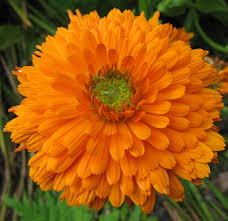
Calendula officinalis goes by many names: Calendula, Marigold or Pot Marigold (not to be confused with modern yellow and orange marigolds of the genus Tagetes) Poet’s Marigold, Scotch Marigold, golds or ruddles. These large, yellow and orange daisy like flowers come from tufted, light green, lance shaped leaves. We will take a quick look at the history, uses, and cultivation of this adorable and useful plant.
Calendula has been used for centuries. Calendula petals contain a coloring substance called calendulin. This has been used in place of saffron to add color to rice, cheese and butter. The green leaves have been served with spinach as a vegetable. The blossoms can be infused in wine which supposed to “soothe a cold stomach”. The flower petals are antiseptic and anti-inflammatory, so it can help keep infections away and is a common ingredient in creams, salves, and ointments for skin conditions. One source says the plant was thought to draw “evil humours” out of the head, strengthen eyesight, and protect one from poisoning and angry words.
It was used as a seasoning since it has a slight pepper flavor. The Romans used leaves and flowers in salads and as seasonings. The Saxons possibly used it in place of pepper. During the civil war and world war one calendula was used as medicine – the flowers were gathered, and petals were made into an ointment used to dress wounds. Calendulas have been popular in bouquets and nosegays, in addition to their beauty, the strong odor was said to have been helpful to keep ladies awake during long sermons. Now calendula is used to garnish salads and meats. It can be added to egg dishes and fruit breads for color and a little flavor. A warning though, eating calendula was supposed to make one feel more amorous, see fairies, or go to sleep faster.
Growing calendula is fairly easy. Seeds can be started indoors four to six weeks before the last frost. The seeds can also be direct seeded in the garden, with seeds spaced 9-12 inches apart. They like average, well-drained soil and full sun. The plants have light green leaves and daisy like flowers in shades of yellow and orange. They can grow up to 2 feet tall but there are shorter varieties available. The more you pick the flowers, the more the plant blooms. Because they have large blooms and stiff stems they make excellent cut flowers. To harvest the flowers, pinch the head from the stem, pluck out each petal and dry in the shade on paper (they stick to screens) and once dry, store in a moisture proof container. They can be infused in oil, added to soaps, creams and ointments.
— Pam Cuttlers (2019)
Presented in 2017:
History: Calendula (Calendula officinalis) also known as “pot marigold” is a native of the Mediterranean and Iran. It has been distributed around the world as a garden plant. This sunny little flower – the “merrybuds” of Shakespeare was first used in Indian and Arabic cultures, before being discovered by the ancient Egyptians and Greeks. The Egyptians valued the calendula as a rejuvenating herb and the Greeks garnished and flavored food
with the petals. The botanical name comes from the Latin calendae, meaning the first day of the month. In India, wreaths of calendula were used to
crown the gods and goddesses. In medieval times, the leaves were considered an emblem of love. To dream of calendula wreaths was a sign of all good
things. During the Civil War, calendula leaves were used on the battlefield to treat open wounds.
Cultivation: Calendula is a hardy annual with a height and spread of 24 in. that grows in all zones. It has daisy-like yellow or orange flowers. Seeds can be sown in the ground or in containers in spring. Calendula prefers a sunny location and welldrained soil. Flowers should be dead-headed to promote more blooms. Flowers should be picked just as they open in summer for fresh use and drying.
Uses: Calendula petals may be used as a culinary dye in butter, oil and cheese and as a “poor man’s saffron” in rice. They are also lovely in salads and omelets and make an interesting cup of tea. They can also be used in baking. The leaves can be used in salads. There are many skin and cosmetic
preparations that contain calendula. The flowers also contain antiseptic, antifungal and antibacterial properties that promote healing so they are used medicinally as well.
— Janet Lindsteadt (2017)
